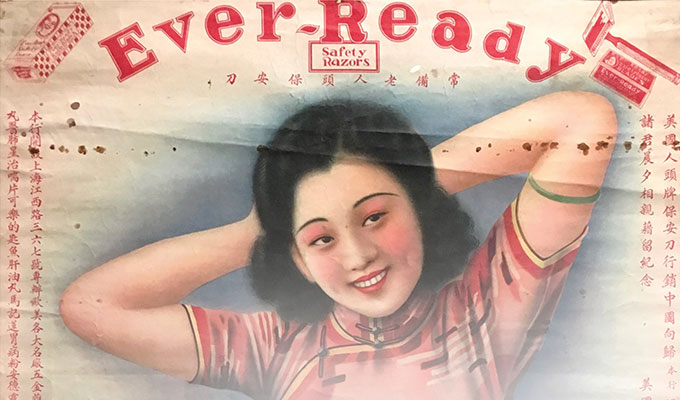Smoking, to the women of 1920s and 30s Shanghai, was terribly classy. It was the epitome of “modeng” (摩登), a transliteration of the English “modern”, which nodded to a radically transformed urban lifestyle amidst a wave of new found wealth and materialism.
Colourful posters depicting idealised women appeared in the thousands in the early 20th century and a good chunk of them are on display at the Jiangsu Museum of Art until June.
Women pose in figure-hugging qipao, revelling in material pleasure as they gaze directly to the viewer from every angle they are viewed. Doused in images of modernity; classical sculptures, aeroplanes and grand pianos; each poster is framed within a traditional hanging scroll format complete with printed silk border.
Often the subject of the posters seems completely unrelated to what they are selling. A newlywed stepping into her terrace home accompanied by a flower girl does not seem like prime material for a cigarette advert. Nor does a young lady sat among pine trees in a decorative qipao entice me to buy electric batteries.
What these posters were selling was much more than individual commodities. Using the sensations created by highly sexualised female figures, these posters sold a lifestyle of pleasure where material assets were both desirable and attainable.
Propelled by advances in printing technology, calendar posters of the 19th century evolved into a powerful advertising mechanism by the 1920s and 30s. Once essential household furniture used to track agricultural dates in the lunar calendar, they began to show the newly introduced Western calendar. Except it was not just the dates you were expected to follow, it was the fashionable lifestyle depicted alongside.
The exhibition today fits rather awkwardly into a year concentrated on women. In 2018, Britain marks a century since women won the right to vote, while globally the #MeToo movement of recent months has brought to fore poignant debate about women and femininity today.
At Jiangsu Museum of Art, women are still idealised, sexual beings and little effort is made to explain the context in which these posters were made and used, or how they relate to women today.
Of course, the posters themselves are primarily historical objects. As adverts they served a purpose; to sell commodities. Look at me lounge in my qipao as I smoke graciously among blossoming roses. Don’t you want to be me?
The romanticised modern woman was at the core of each and every one of these posters, but it is up to today’s curator how to present this once visual ideal to a 21st century audience. Nowhere in the exhibition are we told who the posters were made for, where they were hung or how they were perceived. We view them, therefore, not within a historical context, but as potent advertisements still effective today.
Only four of the twenty or so visitors during my visit were male. Three sat on a bench patiently waiting for their other halves; one diligently took photos of his girlfriend through frames suspended from the ceiling.
Concluding the exhibition, these frames not only encourage, but force female visitors to draw a parallel between the women in the posters; their seeming perfection and modern beauty, and the viewers themselves. Or rather, the female identity they wish to portray, captured within a frame and defined in two dimensions.
“Preserving Modernity” is on display at the Jiangsu Museum of Art, 266 Changjiang Road 江苏省美术馆长江路266号, until 17 June 2018.









